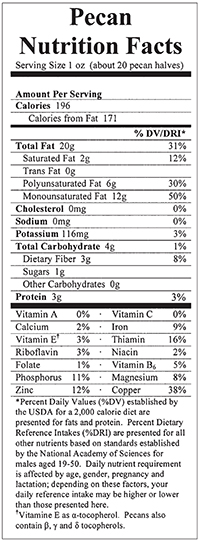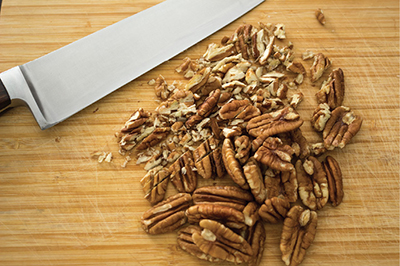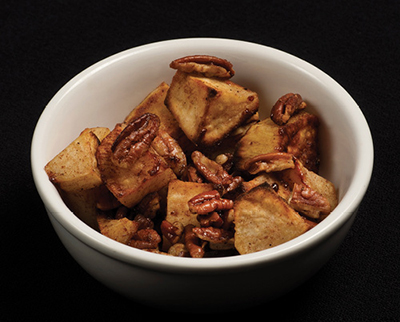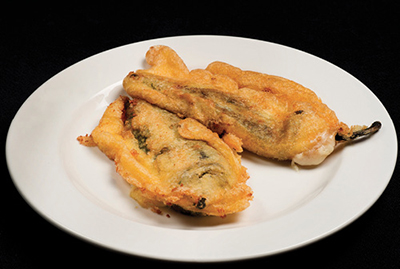Pecans: A Healthful New Mexico-grown Food
Guide E-138
Revised by Richard Heerema, Raquel Garzon, and John Hartley
College of Agricultural, Consumer and Environmental Sciences, New Mexico State University
Authors: Respectively, Extension Pecan Specialist, Department of Extension Plant Sciences; Extension Nutrition and Wellness Specialist, Department of Extension Family and Consumer Sciences; and Assistant
Professor, School of Hotel, Restaurant and Tourism Management, New Mexico State University. (Print Friendly PDF)
Did you know that pecan nuts are the only major tree nut crop that originated in North America? For centuries, pecan nuts were enjoyed by Native Americans across what is now the south-central region of the United States. American settlers in the 1800s brought pecan trees westward to New Mexico, and soon after recognized the Mesilla Valley’s soils and climate as ideally suited to producing top-quality pecans. As a result, southern New Mexico is now one of the world’s premier pecan growing areas, and pecan nuts have come to be featured prominently in New Mexico’s distinctive cuisine.
Recently, pecans have received a lot of very positive attention because of a significant shift in how scientists now think about fats in the diet. We now know that the fat in nuts and other foods has many positive health benefits. It wasn’t too long ago that people were discouraged from eating nuts due to their high fat content. Research, some of which was conducted at New Mexico State University, has shown that regular pecan nut consumption may in fact have a number of important health benefits, and recent studies have shown that the pruning and fertilizer practices used by New Mexico farmers may actually enhance the health-promoting components of pecan kernels even more!1

© Mona Makela | Dreamstime.com
More About Pecans And Their Health-Related Benefits
- Pecans are high in unsaturated fats, which have a positive impact on our blood cholesterol levels, and low in saturated fats, which have a negative impact on our blood cholesterol levels. It is recommended to replace the consumption of saturated fats with unsaturated fats to decrease the risk of heart disease.
- Pecans are also an excellent source of the monounsaturated fat called oleic acid, which is also found in olives and olive oil and is recommended for reducing the risk of heart disease. A recent study found that 8.5% of heart-related deaths in the U.S. in 2012 were associated with low nut/seed consumption.
- Pecans are a good food source of other nutrients that contribute to heart health and provide other health benefits. These include vegetable protein, dietary fiber, vitamins, minerals, phytosterols, and phenolic compounds. Important vitamins found in pecans include folic acid, niacin, vitamin B6, and vitamin E. Pecans are also a good source of important minerals such as copper, magnesium, calcium, and potassium, which are important for maintaining healthy blood pressure, bones, and muscles, including the heart.
- Pecans are also among the best food sources of phytochemicals that are antioxidants. Pecans rank the highest among all nuts in their total antioxidant capacity. In fact, the form of vitamin E in pecans is a unique form called gamma-tocopherol that has powerful antioxidant properties. Antioxidants play a key role in the prevention of a number of diseases. Nutrition scientists recommend these substances because they may reduce the risk of cancers and heart disease. Some studies have shown that these phytochemicals could provide intestinal health benefits and protect against stroke.
- Pecans have a concentrated amount of plant sterols that have been shown to lower bad cholesterol (LDL) levels. Pecans contain a plant sterol called beta-sitosterol that inhibits the absorption of cholesterol in the body, which in turn helps lower blood LDL levels. A New Mexico State University experiment found that eating pecans every day for eight weeks helped lower volunteers’ LDL cholesterol by 6%.
- Apart from reducing the risk of heart disease and lowering LDL cholesterol levels, research has found an association with the consumption of pecans and other nuts and the reduced incidence of gallstones, reduced blood pressure, reductions in abdominal fat, decreased insulin resistance, and reduced risk of type 2 diabetes.
- Pecan nuts contain few carbohydrates and are a very low glycemic index food, which means that eating pecans has little impact on blood glucose (blood sugar) after meals. In fact, a meal or snack that includes pecans can prevent sharp rises in glucose and triglycerides (a type of fat in our blood) after eating. As such, eating pecans in appropriate portions is consistent with a healthy diet for people with diabetes or those at risk of getting diabetes.
- Consuming pecans has not been associated with weight gain and has instead been shown to possibly aid in weight loss and maintenance, improving metabolism, and enhancing feeling full or physically satisfied after eating.
- Pecans, along with other nuts, in the diet may also help to reduce inflammation in the body. Inflammation plays a role in various diseases and conditions. Studies have shown that including nuts in the diet reduces inflammatory markers that are associated with diseases, including heart disease.
- Pecans and other nuts are an important part of the Mediterranean diet, which is an eating plan associated with a decreased risk of heart disease. They are also an important part of the MIND diet (Mediterranean-DASH Intervention for Neurodegenerative Delay) that has been associated with protection of the brain and the prevention of dementia and Alzheimer’s disease. The MIND diet, which includes the consumption of 10 brain health food groups, recommends nuts as one of those food groups. A study showed that people with the highest MIND diet scores had brains that were about 7.5 years younger than people with the lowest MIND diet scores.

Pecans and Allergies
For most people, pecans can be eaten as part of a healthy diet. However, it is possible to be allergic to pecans. Tree nuts—such as almonds, Brazil nuts,
cashews, hazelnuts, macadamia nuts, pecans, pine nuts, pistachios, and walnuts—have been implicated in allergic reactions in both children and adults. Allergic reactions to tree nuts can range from mild to severe (including life-threatening).
One research study, using a random survey of about 13,500 people in the U.S. (adults, adolescents, and children), found that about 1 out of 250 people had an allergy to tree nuts.
A person can be allergic to only one specific kind of nut and not allergic to others, or they can have an allergy to more than one kind of nut. Most experts advise patients who are allergic to a specific tree nut to avoid all tree nuts (as well as the peanut, which is not a tree nut).
Pecans and pecan butter may be a good substitute for some people with a peanut allergy but who do not have allergies to tree nuts.

© Atmospherics | Dreamstime.com
Adding Pecans to your Diet
Pecans are a high-calorie food and are often included as part of sugary recipes such as pecan pies, pralines, or cookies. Families should take this into account when it comes to maintaining a healthy weight. However, pecans also contain many desirable nutrients for health, so pecans may be included in modest amounts as part of a healthy diet. A standard portion size of pecans is about 18–20 pecan halves. This is also the amount that is recommended to increase the likelihood of the health benefits associated with pecans. The amount does not need to be consumed at one time, but can be spread out throughout the day if desired. Pecans can be eaten plain as a healthful snack instead of chips or sweets, and also make an excellent addition to salads, breakfast cereals, breads, entrees, and side dishes. The delicious taste of pecans enhances the flavor of many recipes that are family favorites. Most people are accustomed to seeing raw or roasted pecan halves, but you can also find other processed forms of pecans that can be used in recipes or as a substitute to other nut butters, such as peanut butter. Here are other forms to look for:
- Pecan oil
- Pecan butter
- Pecan flour
Pecan Recipes

Roasted Sweet Potatoes with Pecans
2 large or 3 medium/large sweet potatoes, washed, peeled, and trimmed into 1-inch chunks
2 cups pecan halves or pieces
4 tablespoons honey
2 tablespoons vegetable oil
2 tablespoons butter, melted
2 teaspoons cinnamon
1 teaspoon nutmeg
1 teaspoon allspice
Salt and pepper to taste
Directions
- Preheat oven to 400°F.
- Toss potato chunks in mixing bowl with honey, oil, butter, and spices.
- Transfer potatoes to an oiled sheet pan, using a slotted spoon to reserve extra marinade in the bowl, and arrange in a single layer in the pan.
- Bake potatoes for 20–25 minutes. While potatoes are baking, add pecans to excess marinade and toss to coat well.
- Remove potatoes from oven. Turn potatoes over, then sprinkle with pecans and reserved marinade.
- Bake an additional 15–20 minutes until potatoes are soft to a fork, being careful not to burn.
- Serve immediately.
Pecan-stuffed Chile Rellenos
6 long green chile peppers (such as Big Jim, Sandia, or Anaheim), roasted and peeled
6 ounces asadero cheese or queso quesadilla, cut into long strips
2 ounces cotija cheese, crumbled
4 ounces pecan pieces
2 eggs, separated
1 teaspoon baking powder
3/4 cup all-purpose flour
1 cup lard (or shortening)* for frying (*caution: look for ones with no trans fats)
Directions
- Cut a slit along the side of each pepper to remove the seeds and core, but leave stems attached.
- Dry peppers well to help the batter stick and to prevent them from being “watery” inside after being cooked.
- Stuff the peppers with both cheeses and pecans, trying to distribute evenly along the length of the pepper.
- Whisk the egg yolks in a bowl with the baking powder. In a second metal bowl, beat the egg whites with an electric mixer until the whites form stiff peaks. Gently fold the beaten egg whites into the yolk mixture.
- Place flour into a shallow bowl.
- Heat the lard in a skillet over medium heat.
- Roll each stuffed pepper in flour, tap off excess flour, and dip the peppers into the egg mixture to coat both sides. Gently lay the coated peppers into the hot oil.
- Let fry on one side until golden brown (about 5 minutes), turn, and fry second side until golden brown and cheese is melted. Note: When frying, use only a moderate heat where food should bubble/sizzle gently; if the heat is too high, the rellenos will burn before the cheese is melted.
- Serve plain or topped with your favorite chile sauce.
Winter Salad
1 small head escarole, torn into 1 1/2-inch pieces
2 Belgian endive, leaves separated
2 celery stalks, cut on a sharp diagonal into thin slices
1 1/2 tablespoons white wine vinegar
1/4 cup extra-virgin olive oil
Salt and freshly ground black pepper
1 Granny Smith apple, halved, cored, and thinly sliced
1/2 cup pecans, toasted
1/3 cup shaved Parmigiano Reggiano cheese
Directions
- In a bowl, toss together the escarole, endive, and celery and place in the refrigerator.
- In a small bowl, whisk together the vinegar and olive oil. Season to taste with salt and pepper.
- To serve, toss the escarole, endive, and celery with the vinaigrette, apples, pecans, and Parmigiano. Place in a salad bowl and serve immediately.
Pecan Cake
Butter, as needed
Flour, as needed
8 eggs, separated
1 1/2 cups sugar
1 teaspoon cinnamon
1 teaspoon lemon zest
1/2 teaspoon vanilla extract
2 cups finely ground pecans or pecan flour
Directions
- Preheat oven to 400°F.
- Butter an 11-inch round cake pan with 2-inch sides and then dust it with flour, shaking out any excess.
- In a large bowl, combine the egg yolks and sugar and whisk together until smooth and foamy.
- Add the lemon zest, cinnamon, and vanilla and mix well.
- Add the ground pecans a little at a time, mixing well after each addition to incorporate fully.
- Using a whisk or a handheld mixer, beat the egg whites until they form soft peaks.
- Scoop about one-third of the whites into the egg yolk mixture and, using a rubber spatula, fold them in to lighten the mixture. Then add the remaining whites and fold them in gently but thoroughly, deflating the batter as little as possible.
- Transfer the batter to the prepared pan. Bake the cake for about 30 minutes, or until a knife inserted into the center comes out clean.
Pecan Pie Smoothie
Recipe courtesy of Sheree Clark, Fork in the Road, https://www.fork-road.com; reprinted with permission.
Grade B maple syrup provides a nice rich, strong maple flavor, but you can use your favorite type. Just be sure you don’t use artificial syrup to keep this smoothie recipe healthy!
1 cup raw pecans, soaked for 2 hours or more
2 cups filtered water
2 frozen bananas
3 large romaine lettuce leaves
1 tablespoon ground flaxseed
2 tablespoons pure maple syrup
2 teaspoons vanilla extract
1/2 teaspoon cinnamon
Pinch of unrefined salt
Directions
- Put all ingredients in blender and puree until smooth.
Sweet Red Chile Pecans
A great addition to salads, stuffing, or side vegetables, or as a snack by themselves.
2 cups pecan halves
1/2 cup packed light brown sugar
4 teaspoons salt
3 teaspoons red chile powder
2 teaspoons garlic powder
2 teaspoons dried thyme
2 teaspoons ground cumin
1 teaspoon onion powder
1/2 teaspoon cayenne pepper
Directions
- Mix all ingredients except pecans in a mixing bowl.
- Add pecans and toss until well coated.
- Spread pecans evenly on a sheet pan, preferably lined with wax paper or parchment.
- Roast in the oven at 350°F until well toasted.
- Cool and serve.
Honey-pecan Tart
A different—and indulgent—twist on pecan pie.
Pastry
2 cups plain flour
1/2 cup butter, diced
2 tablespoons powdered sugar
1 egg
Filling
1/2 cup unsalted butter, diced
1/2 cup sugar
3 eggs, beaten
2/3 cup honey
Juice and zest of 1 lemon
3 cups pecan nuts
Pinch of salt
Powdered sugar, for dusting
Directions
- Preheat oven to 350°F.
- Sift the flour into a bowl, add the butter, and use your fingertips to work the mixture until it resembles fine breadcrumbs.
- Stir in the powdered sugar, add the eggs and 1 tablespoon of water, and work on the dough until it becomes firm and leaves the edges of the bowl clean.
- Roll out the pastry onto a floured surface and use it to line a 9-inch tart tin.
- Prick the pastry shell with a fork and chill it for 10 minutes. Then line it with aluminum foil or greaseproof paper and fill the pastry shell with dried beans or rice, or baking beans, and bake the pastry shell for 10 minutes.
- Cream together the butter and sugar until the mixture is light, then beat in the eggs one at a time.
- Gently heat the honey in a small pan until it is of a runny consistency, then add it to the butter mixture with the lemon zest and lemon juice.
- Stir in the pecans and salt, then pour the filling into the pastry shell.
- Bake the tart for about 45 minutes, until the filling is lightly browned and set.
- Leave the tart to cool slightly in the tin, then dust generously with powdered sugar.
- Serve the tart warm or at room temperature.
Oven-fried Pecan Catfish
4 tablespoons Dijon mustard
3 tablespoons milk
1/2 cup pecans (more may be needed depending on the size of the fish fillets)
4 catfish fillets (or other white fish)
Directions
- Preheat oven to 450°F.
- Finely chop pecans to about the consistency of peanut topping for sundaes.
- Mix mustard and milk.
- Place catfish fillets in an oiled oven-proof pan with the skin side down.
- Brush the fillets generously with the mustard mixture.
- Coat fish completely with a packed-on layer of chopped pecans.
- Bake for approximately 15 minutes, or until fish is firm and pecans begin to brown.
All recipes developed and provided by Chef John Hartley and the School of Hotel, Restaurant and Tourism Management, College of Agricultural, Consumer and Environmental Sciences, New Mexico State University, unless otherwise noted.
Sources
Haddad, E., P. Jambazian, J. Tanzman, and J. Sabaté. 2001, March. Effect of a pecan rich diet on plasma tocopherol status [Abstract]. FASEB Journal. Research presented at the April Experimental Biology 2001 Meeting, Loma Linda University, School of Public Health, Loma Linda, California.
Heerema, R., M.L. Wells, L. Lombardini, M. Nesbitt, C. Warren, R.B. Pegg, and Y. Gong. 2016. Pecan kernel antioxidant capacity and oil composition are affected by mechanical pruning and by nut position in tree canopy. Acta Horticulturae, 1120, 499–506.
Micha, R., J.L. Peñalva, F. Cudhea, F. Imamura, C.D. Rehm, and D. Mozaffarian. 2017. Association between dietary factors and mortality from heart disease, stroke, and type 2 diabetes in the United States. Journal of the American Medical Association, 317, 912–924. doi: 10.1001/jama.2017.0947
Morgan, W.A., and B.J. Clayshulte. 2000. Pecans lower low-density lipoprotein cholesterol in people with normal lipid levels. Journal of the American Dietetic Association, 100, 312–318.
Morris, M.C., C.C. Tangney, Y. Wang, F.M. Sacks, D.A. Bennett, and N.T. Aggarwal. 2015. MIND diet associated with reduced risk of incidence of Alzheimer’s disease. Alzheimer’s and Dementia, 11, 1007–1014. doi: 10.1016/j.jalz.2014.11.009
National Academy of Sciences, Institute of Medicine, Food and Nutrition Board (https://www.nationalacademies.org/hmd/Global/Topics/Food-Nutrition.aspx)
National Institutes of Health, National Heart, Lung, and Blood Institute (www.nhlbi.nih.gov)
Ros, E. 2010. Health benefits of nut consumption. Nutrients, 2, 652–682.
Sabaté, J. 2003. Nut consumption and body weight. American Journal of Clinical Nutrition, 78, 647S–650S.
Sicherer, S.H., A. Muñoz-Furlong, and H.A. Sampson. 2003. Prevalence of peanut and tree nut allergy in the United States determined by means of a random digit dial telephone survey: A 5-year follow-up study. Journal of Allergy and Clinical Immunology, 112, 1203–1207.
Rajaram, S., K. Burke, B. Connell, T. Myint, and J. Sabaté. 2001. A monounsaturated fatty acid-rich pecan-enriched diet favorably alters the serum lipid profile of healthy men and women. Journal of Nutrition, 131, 2275–2279.
United States Department of Agriculture. 2015. Dietary Guidelines for Americans 2015–2020. Washington, D.C.: USDA. Available online at https://health.gov/dietaryguidelines/2015/guidelines/
United States Department of Agriculture, Nutrient Data Laboratory (www.ars.usda.gov/nutrientdata)
Wang, Y. 2016. The nutraceutical properties including antioxidant capacity of ‘Wichita’ and ‘Western’ pecan kernels are affected by soil zinc fertilizer application [Master’s thesis]. Las Cruces: New Mexico State University.
Wu, X., G.R. Beecher, J.M. Holden, D.B. Haytowitz, S.E. Gebhardt, and R.L. Prior. 2004. Lipophilic and hydrophilic antioxidant capacities of common foods in the United States. Journal of Agricultural and Food Chemistry, 52, 4026–4037.
Yochum, L.A., A.R. Folsom, and L.H. Kushi. 2000. Intake of antioxidant vitamins and risk of death from stroke in postmenopausal women. American Journal of Clinical Nutrition, 72, 476–483.
Footnotes
1Heerema et al., 2016. Acknowledgment: Research was funded by USDA-NIFA-SCRI Award No. 2011-51181-30674.
For further reading
E-131: In a Pinch Ingredient Substitution
https://pubs.nmsu.edu/_e/E131/
E-215: High-altitude Cooking
https://pubs.nmsu.edu/_e/E215/
CR-517: New Mexico Favorites: Chile and Pecans
https://pubs.nmsu.edu/_circulars/CR517/

Richard Heerema is the Extension pecan specialist. He earned his Ph.D. in plant biology from the University of California—Davis. His research includes micronutrient nutrition, irrigation efficiency, rootstocks, and alternate bearing in pecan. His Extension work provides New Mexico's growing pecan industry with research-based information and tools needed to maximize profitability and sustainability.
To find more resources for your business, home, or family, visit the College of Agricultural, Consumer and Environmental Sciences on the World Wide Web at pubs.nmsu.edu
Contents of publications may be freely reproduced for educational purposes. All other rights reserved. For permission to use publications for other purposes, contact pubs@nmsu.edu or the authors listed on the publication.
New Mexico State University is an equal opportunity/affirmative action employer and educator. NMSU and the U.S. Department of Agriculture cooperating.
Revised August 2018 Las Cruces, NM





